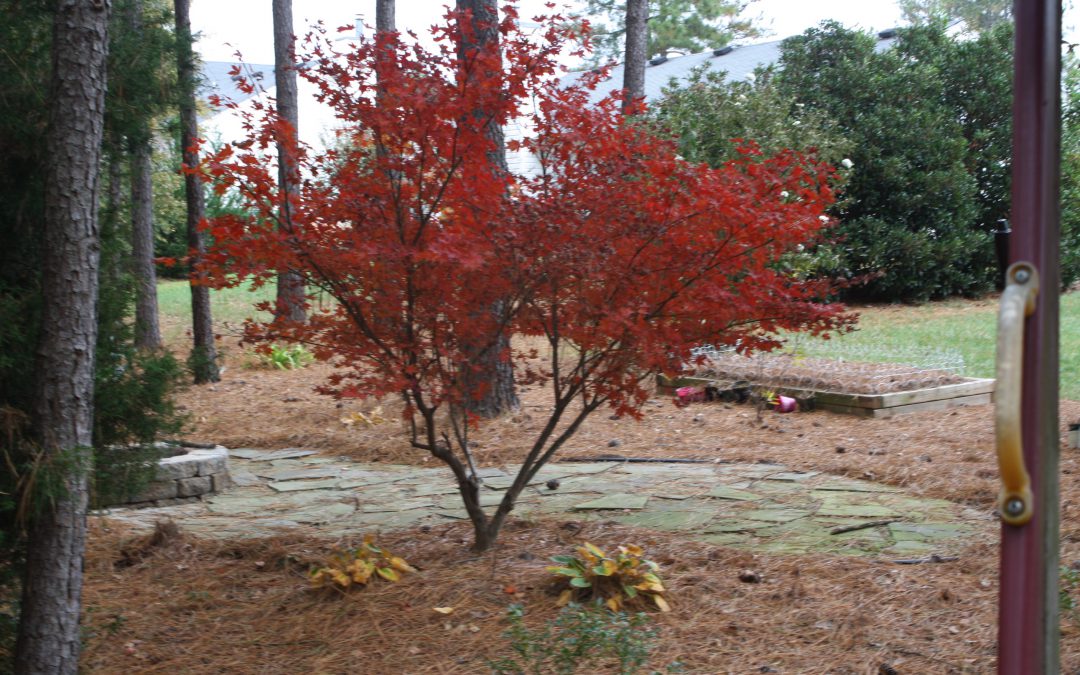
by Julie McConnell | Dec 4, 2020
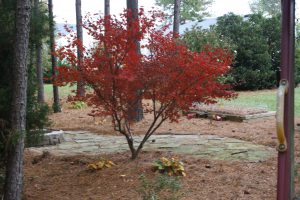
Intense red fall color of Japanese Maple in Georgia is hard to replicate in our climate. J_McConnell, UF/IFAS
Fall is a favorite time of year for many people. Cool nights, short days, football games and the fast approaching holidays are all signs of summer coming to an end. Floridians who have relocated from other parts of the country may be disappointed to realize we get very little showy fall color even though we can grow some of the same trees in North Florida as other parts of the country. Why is that? Well, although plant breeders may promise “showy fall color” in certain selections, they really can’t promise that year after year because it’s more than just genetics influencing leaf color. Let’s take a deeper dive into the science behind fall color!
Why do the leaves change color?
Lower temperatures and shorter day length indicate to plants that winter is approaching and some physiological changes start to occur. Chlorophyll is a pigment found in leaves that, in addition to capturing sunlight and producing energy, also causes plants to display green during the growing season. As fall approaches, environmental changes tell plants to stop producing chlorophyll and existing pigment begins to break down. The reduction of chlorophyll allows the other pigments present (carotenoids and anthocyanin) to reveal their colors in an array of yellows, browns, oranges, reds, and purples. Different plants have different levels of these pigments and some may not exist at all in certain species. This explains why some plants typically turn only yellow and others may show yellow, orange, and/or red!
Why is there so much difference from year to year?
Variation occurs because environmental conditions and cultural practices play a part in determining how much color will be on display. Rainfall or irrigation amounts in the preceding summer and fall, drought cycles, nutrient levels, sunlight, and day and night temperatures all influence color from year to year.
How do I increase the potential for showy fall color in my landscape?
Choose plants with the reputation of producing desired fall colors in our area. However, keep in mind that because of the influence of outside conditions, you may be in for a surprise from year to year. To increase your chance of having a somewhat predictable fall display, use cultivars instead of seedlings of a plant species. A cultivar is a selection of a plant species that has been chosen for desirable traits, like growth habit, flowering, or fall color. These attributes are usually easily identified by the way their names are assigned. For example, Acer rubrum ‘October Glory’ is a red maple cultivar known for a full rounded canopy and exceptional red fall color. The reason that cultivars appear more consistent is because they are genetic copies of the parent plant that they are named for. A species or seedling plant is not a clone but comes from seed, which means you will get as much genetic variation as you see in human siblings. Just like children in our own families, each will each shine in their own way and no two will be exactly alike.
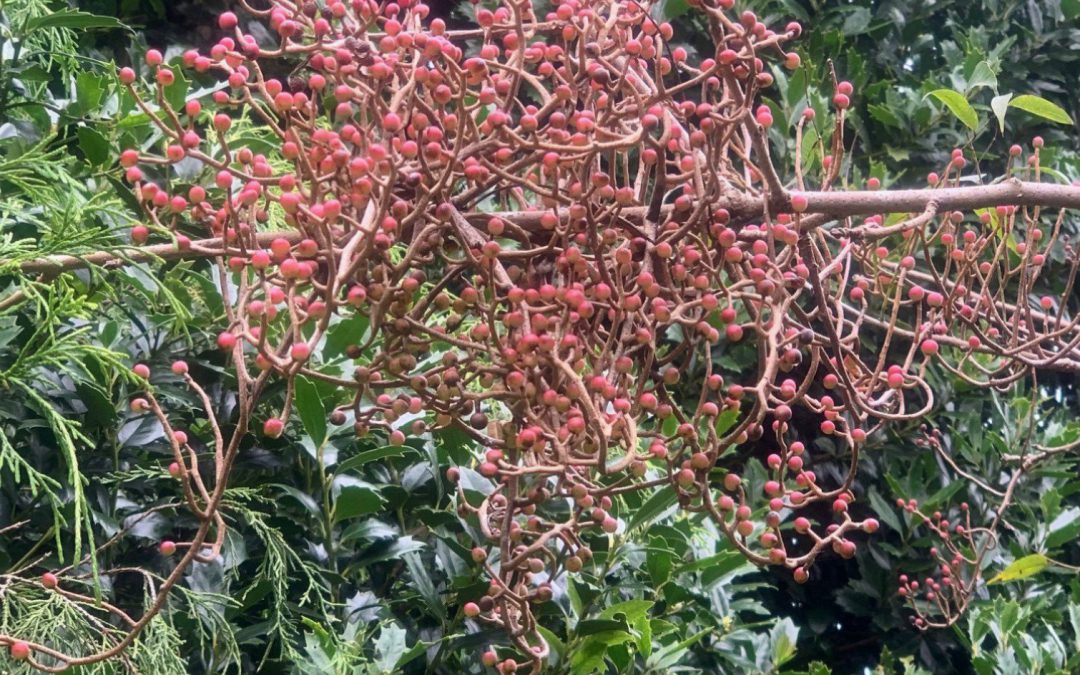
by Beth Bolles | Oct 21, 2020
Many people often request a recommendation for a small tree that will be suitable for their landscape and one to consider is the Chinese Pistache, Pistachia chinensis. Although not a native tree, Chinese Pistache does not have invasive potential so it can make a suitable option for both commercial and residential landscapes.
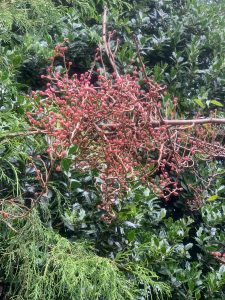
Berries also offer nice fall color. Photo by Beth Bolles, UF IFAS Extension Escambia County
The best features of Chinese Pistache are the fall color it offers with orange leaves, followed by clusters of salmon berries. It will lose its leaves as days shorten but you can enjoy the textured bark during the winter season. Compound leaves offer interest as well during the spring and summer. Adding some medium to fine textured foliage plants under and around trees will provide a nice landscape display.

Chinese Pistache has been an attractive feature in the Escambia County Demonstration Garden for over 20 years. Photo by Beth Bolles, UF IFAS Extension Escambia County
A positive feature of Chinese Pistache is that once it is established, it is tolerant of drought. Expect trees to be about 25 to 30 feet in height with a 20 to 25 foot spread. Each tree will have it own unique branch structure and some pruning will be required when trees are young to develop strong connections. You may plant as a full sun tree to provide a little dappled shade for your garden or use as an understory tree in partial shade.

by Beth Bolles | Aug 28, 2019
More and more homeowners are incorporating edible plants into their home landscape in order to enjoy the fresh taste of fruits and vegetables. Another trend to consider this coming cool season is to start a few common flowers that can serve as flavor enhancements for many of your dishes.
There are numerous plants that we commonly grow that have edible flowers but before striking out on your first taste test, be sure to research first. Always remember the common saying that every flower is edible once. Find a reputable reference guide from a friendly neighborhood Extension office for a list of common edible flowers, then be ready to start from seeds. It is best not to purchase transplants from an ornamental nursery unless you are sure of all the treatments for that plants. Nurseries are often selling these for beauty alone, not with intention that they will be eaten.
Here are a few edible flowers to try:
Pot marigold or Calendula is a wonderful cool season flower on its own. Brightly colored orange or yellow flowers improve the drab colors of our cool season and plants are sturdy annuals for borders, mass plantings, or in containers. Petals have a peppery flavor and add spice to salads and sandwiches. You may also add flowers to soups, fishes and butters for added coloring. Calendula petals can be a saffron substitute.
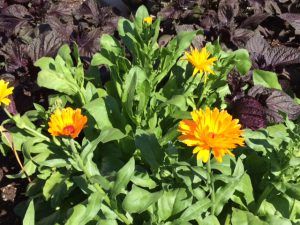
Calenduala is easily started from seeds and will reseed in your garden once established. Photo by Beth Bolles, UF IFAS Extension Escambia County.
The well known dianthus is a great transition plant as our days cool and warm up again the spring. Use as front of the border plantings or in containers as a filler. When harvesting petals of dianthus, you will want to remove the white petal base which is a little bitter. The flavor is a little more delicate than cloves so you can add petals to punches, desserts, and fruit salads.
If you like a little more spice, try nasturtiums. We often plant these after the last frost and they grow until we get too hot. Since our fall weather is so unpredictable, you may be able to start some seeds for a fall planting and have flowers before our first cold spell. Either way, nasturtium flowers are often sliced for salads and sandwiches as a mustard or pepper substitute. You can also mince flowers to add to a butter. If you let some flowers go to seed, collect the unripe seeds to make a caper substitute vinegar.
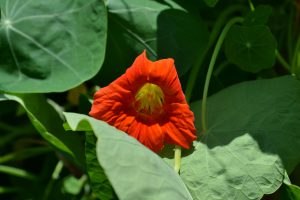
Grow nasturiums during our transition times of spring and fall. Photo by Beth Bolles, UF IFAS Extension Escambia County.
If you are going to use edible flowers from your garden remember to keep all non food labeled pesticides away from plants. Harvest flowers at their peak after the dew dries. Separate petals from other flower parts and if you have allergies be sure to remove any pollen. Place flowers in a moist towel in the refrigerator if you will not use them immediately. Rinse carefully so not to damage tender petals.
There are many other ornamental plants that offer edible flowers you may want to consider growing in the future. These flowers not only enhance the look of the dish but can offer unique flavoring from a locally grown source – your own backyard.
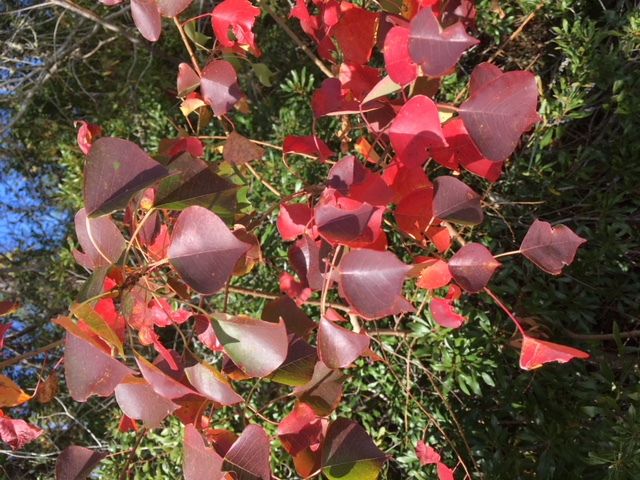
by Julie McConnell | Dec 1, 2017
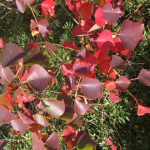
Chinese tallow displays red fall color in North Florida. Photo: J_McConnell, UF/IFAS
In northwest Florida as we transition into fall, we don’t usually see a spectacular display of color change in the forest or our landscapes. Mixed in with the evergreen pines, oaks, and magnolias, we get sporadic spots of yellow and red from our native hickories, sweetgum, and sumac but otherwise it can be rather dull. It’s no wonder that people are reluctant to part with a blaze of red in their landscapes in the form of the invasive Chinese Tallow (Sapium sebiferum L. aka Triadica sebifera L.).
This fast growing, deciduous tree was initially introduced to the United States in 1776 by Benjamin Franklin. It was promoted by the U.S. Department of Agriculture in the early 1900s for the potential to create a soap industry. It was planted as an ornamental because it grows quickly in nearly any type of site condition, has attractive white fruit, and red fall color. Unfortunately, over the years it spread into numerous states and habitats unchecked displacing native vegetation and disrupting wildlife food sources. Eventually, it was recognized as an invasive pest and is currently listed as a noxious weed in Florida, Louisiana, Mississippi, and Texas.
Chinese Tallow is a prolific seed producer and is sexually mature as young as three years and may continue to produce viable seeds to the ripe age of 100. Although some birds eat the berries (part of the dispersal method), sap in the leaves and berries are poisonous to some other animals including cattle.
To prevent the continued spread of this plant, consider removing from your property and replacing with native species. Buy plants from reputable licensed nurseries with good weed management programs. Be able to recognize Chinese Tallow and do not accept plants from well-meaning gardeners who wish to share a foolproof shade tree!

by Sheila Dunning | Oct 2, 2017
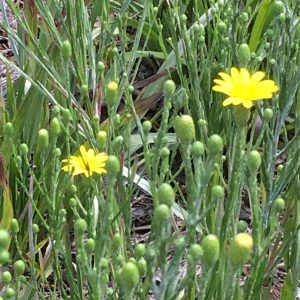
Silkgrass Pityopsis spp. Picture by: Sheila Dunning
Each fall, nature puts on a brilliant show of color throughout the United States. As the temperatures drop, autumn encourages the “leaf peepers” to hit the road in search of the red-, yellow- and orange-colored leaves of the northern deciduous trees.
Here in the Florida Panhandle, fall color means wildflowers. As one drives the roads it’s nearly impossible to not see the bright yellows in the ditches and along the wood’s edge. Golden Asters (Chrysopsis spp.), Tickseeds (Coreopsis spp.), Silkgrasses (Pityopsis spp.), Sunflowers (Helianthus spp.) and Goldenrods (Solidago spp.) are displaying their petals of gold at every turn. These wildflowers are all members of the Aster family, one of the largest plant families in the world. For most, envisioning an Aster means a flower that looks like a daisy. While many are daisy-like in structure, others lack the petals and appear more like cascading sprays.
So if you are one of the many “hitting the road in search of fall color”, head to open areas. For wildflowers, that means rural locations with limited homes and businesses. Forested areas and non-grazed pastures typically have showy displays, especially when a spring burn was performed earlier in the year.
With the drought we experienced, moist, low-lying areas will naturally be the best areas to view the many golden wildflowers. Visit the Florida Wildflower Foundation website, www.flawildflowers.org/bloom.php, to see both what’s in bloom and the locations of the state’s prime viewing areas.
And if you are want to add native wildflowers and other Florida-friendly plants to your landscape join the Master Gardeners for their Fall Plant Sale to be held Saturday, October 14 from 8 am to noon at the Okaloosa County Extension Annex located at 127 SW Hollywood Blvd, Ft. Walton Beach.












